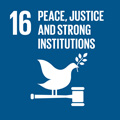- Docente: Rossella Selmini
- Credits: 8
- SSD: SPS/06
- Language: English
- Teaching Mode: Traditional lectures
- Campus: Bologna
- Corso: Second cycle degree programme (LM) in International Relations (cod. 9084)
-
from Feb 19, 2025 to May 16, 2025
Learning outcomes
At the end of this course students: will become familiar with the most important categories to understand and explain the intersection between globalization and crime; will acquire knowledge about how globalization processes affect crime in an historical and in a comparative perspective; will be able to analyse and discuss some of the most important “global” types of crime: transnational organized crime and youth gangs
Course contents
This course explores the connection between globalization, the evolution of criminology and crime, and how this connection changes in space and time. Globalization affects crime and crime control in a variety of ways: creating conditions and opportunities for new types of crime, or reshaping more traditional criminal behaviors, and increasing insecurity and fear of crime. Globalization, in addition, is challenging traditional explanations of crime and dynamics of crime control, policing and surveillance.
The following topics will be discussed:
What is globalization? What is crime and what is crime control?
Criminological theories in an historical and international perspective: from bio-amthropogical theories to contemporary criminology
Crime as a global phenomenon: the case of youth violence and transnational youth gang; gender violence; crime against the environment.
The globalization of policing, surveillance and of strategies of crime control.
Readings/Bibliography
Mandatory readings:
On criminological theories:
Frank P. Williams III, Marylin D. McShane, (2018) Criminological Theory, Pearson, 7th ed.
Chapters: 1, 2, 3, 4, 5, 6, 7 (only Cohen and Cloward & Ohlin) 8 (no “Master Status and Retrospective Interpretation”, and no “Current Directions”W), 11 (no “Containment Theory”, no “Current Directions”) 13, 14 (only “Modern Social Control Theory”), 15 (only Cultural Criminology).
Roger Matthews & Jock Young (1992) “Reflections on Realism”, in J. Young & R. Matthews (eds.) Rethinking Criminology: The Realist Debate, Sage, p. 1-23.
Michael J. Lynch, Paul B. Stretesky (2013) “Green Criminology”, in F. Cullen & P. Wilcox (eds) The Oxford Handbook of Criminological Theories, Oxford University Press, p. 625-644.
On globalization, crime and criminology:
Francis Pakes (2013) (ed) “Introduction” to Globalization and Criminology: An agenda of engagement, London, Routledge, pp. 1-8.
Robert Reiner (2007) "Neo-Liberalism, Crime and Justice", in R. Roberts and W. McMahon (eds) Social Justice and Criminal Justice, London, Centre for Crime & Justice, pp. 8-21.
Nancy Wonders,(2007) “Globalization, Border Reconstruction Projects, and Transnational Crime”, in Social Justice, 34, 2, pp. 33-46.
On gangs:
Jennifer M. Hazen & Dennis Rodgers (2014) (eds) Global Gangs. Street Violence Across the World, Minneapolis, University of Minnesota Press (Introduction).
John Hagedorn (1998) “Gang Violence in the Postindustrial Era”, in Crime and Justice, Vol. 24, Youth Violence, pp. 365-419.
John M. Hagedorn (2005) “The Global impact of Gangs”, in Journal of Contemporary Criminal Justice, 21 (2), pp. 153-169.
Carles Feixa & Oriol Romanì(2014) “From Local Gangs to Global Tribes:The Latin Kings and Queens Nation in Catalonia”, in D. Buckingham. S. Bregg, M. J. Kehily (eds), Youth Cultures in the Age of Global Media, Basingstoke, Palgrave McMillan, pp. 88-103.
On social control and policing:
Martin Innes (2003) Understanding social control. Deviance, Crime and social order, Maidenhead, Open University Press, chapter 5 “Policing” pp. 63- 79; chapter 7, ”The Architecture of social control”, pp. 95- 110; chapter 8, ”Surveillance”, pp. 112-129.
Michael Cavadino, James Dignan (2006) "Penal policy and political economy", in Criminology & Criminal Justice, 6(4), pp. 435–456
All the reading materials (except the book by Williams III & McShane) will be available on the course website.
Further readings (non-mandatory) will be suggested and posted on the class website. For non-attending students, extra reading will be required.
Teaching methods
Lectures, small groups activities, students presentations and class discussions, movies and documentaries, guest speakers. This class is highly interactive and students are invited to participate actively in each class.
Assessment methods
For students who regularly attend classes (80% of all classes) there will be:
-an intermediate written exam (30% of the final grade), based on short answers.
-a final paper (70% of the final grade).
For students not regularly attending there is an oral exam, based on the mandatory readings and on some extra readings (contact the professor for more information on the extra readings).
All tests have the goal to assess students' knowledge of the course's main topics, their capacity of connecting ideas and theories, and of critical thinking.
Teaching tools
Power point; audio-visual materials (movies, documentaries).
Office hours
See the website of Rossella Selmini
SDGs


This teaching activity contributes to the achievement of the Sustainable Development Goals of the UN 2030 Agenda.
